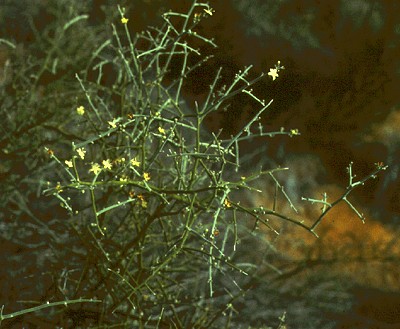 Voucher: L. Haegi 2000, Lake Goongarrie, WA Photo: L. Haegi © L. Haegi |
 Line drawing by R. Roden (from L.Haegi, unpubl. thesis). |

Synonymy
Crenidium spinescens Haegi, Telopea 2: 179 (1981)
T: Mongers Lake [= Lake Monger], W.A., 12 June 1961, C.A. Gardner 13070; holo: PERTH; iso: CANB, K, MO.
Description
Rounded, intricately branched shrub to 1.7 m. Branches spinescent, tomentose with non-glandular dendritic hairs, glabrescent.
Leaves present only on immature parts, scattered, narrowly elliptic to linear, sessile, 3–10 mm long, 0.5–1.5 mm wide, tomentose, entire, the margins slightly recurved.
Pedicels 1–3 mm long. Calyx 1.3–2 mm long, tomentose; lobes minute. Corolla 2.5–4 mm long, tomentose outside; lobes ovate to broadly ovate, 1.5–2.5 mm long. Stamens and style much exserted.
Capsule ovoid, 4–4.5 mm long. Seeds 3.5–4 mm long.
Distribution and ecology
Occurs from Menzies to Lake Moore in southern W.A.
Grows in deep sand on the margins of salt lakes.
Notes
Phylogenetic studies by Garcia & Olmstead (2003) on the Tribe Anthocercideae using two chloroplast DNA regions included this species. Cyphanthers odgersii showed a closer relationship to Grammosolen while the rest of the Cyphanthera species combined to form a clade with Duboisia and Crenidium.
Reference: V.F.Garcia & R.G.Olmstead (2003). Phylogenetics of Tribe Anthocercideaea (Solanaceae) based on ndhF and trnL/F sequence data. Systematic Botany 28: 609-615.
Pharmacology: A discussion of the tropane alkaloids which occur in Crenidium and other Anthocercideae can be found in Griffith & Lin (2000). Hyoscyamine is the predominant alkaloid but others are present.
Ref: W.J. Griffin & G.D. Lin (2000). Chemotaxonomy and geographical distribution of tropane alkaloids. Phytochemistry 53: 627–628.
Selected specimens
W.A.: Lake Seabrook, J.S. Beard 5158 (PERTH); Lake Goongarrie, L. Haegi 2000 (AD, ADW, BIRM, BRI, CANB, CBG, CORD, F, MEL, MO, NSW, NT, PERTH, PRE).
Derivation of epithet
From spinescens, Latin for becoming spiny.
Images and information on web
Further information for this species in WA can be found on the FloraBase site.
Plant status (if any)
Originally classified as Risk Code 3K (Briggs & Leigh, Rare or Threatened Australian Plants, 1995).
No longer classified under W.A. legislation.
Atkins, K.J. (2008). Declared Rare and Priority Flora List for